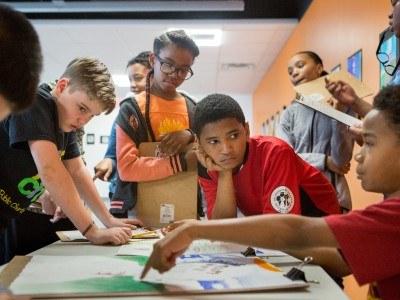Professional Learning
Learning and The Lean Startup
Topics

Educators are the lead learners in schools. If they are to enable powerful, authentic, deep learning among their students, they need to live that kind of learning and professional culture themselves. When everyone is part of that experiential through-line, that’s when next generation learning thrives.
Lessons for redesigning K-12 schools from The Lean Startup by Eric Ries.
Since NGLC’s recent investments (Waves IIIa, IV) have been about starting new Breakthrough Schools, I decided it was time to pick-up The Lean Startup by Eric Ries. Eric defines a startup as an organization dedicated to creating something new under conditions of extreme uncertainty. Launching a new school model is risky business and very hard work. Many new schools have to close their doors shortly after opening, lose top talent, struggle with governance and facilities, and fail to generate a self-sustaining financial model. I was pleasantly surprised to find the author also included examples from large established companies where seasoned managers are attempting to launch new products. Many of the Lean Startup pressures and processes translated to these large organizations, so this book is relevant to established districts and Charter Management Organizations (CMO’s), state departments of education, postsecondary institutions, third party education vendors and nonprofits (that is, the entities included in NGLC’s expanded Wave IV invitation).
For me, the big take away idea from this book revolves around what success looks like and strategies for getting there. In this case, it comes down to a startup team’s ability to learn and to learn fast (the author lays out a methodical process (build, measure, learn) for this and calls it validated learning). Next, the team must be able to apply the learning in a flexible manner to the re-design of the product or service. This is the step that ensures that what results truly brings value to the customer—or in the case of schools, the student–and thus, results in a successful new venture. The author also debunked a few myths for me. For example,
- Having a vision (good idea) and persevering does not guarantee success.
- You don’t have to create a perfect product before finding out what customers want.
- You don’t need a bunch of upfront capital to launch.
Many startups and new schools invest a lot of time and money in development to produce a perfect product and only then release it to discover how it’s received. How do students react? Do they learn more or faster? What happens if students don’t like the school or a certain learning product? Time, talent and money are lost. Instead, the author recommends that entrepreneurs identify the primary assumptions (called underlying leaps of faith) behind the product or service first (e.g. students want to use social networking technology in their daily learning; students learn in one of three ways; students will be hired if they have some technical skills along with their academic notions; students will learn in the out-of-school hours if enabled to do so, etc.). Then, go about testing those assumptions by using a less-than-perfect version of the product or service with students over a short cycle (maybe 1-2 weeks). Make adjustments. Repeat for each assumption.
This iterative process enables an entrepreneur/education leader to see what students really want (based on real behavior) which is not always the same as what the startup team envisioned nor what students would have reported had they been asked in advance. When student feedback and performance data reveals the startup team’s assumptions are not quite right, it’s important to make tweaks or adjust (called the pivot) to meet students demonstrated needs. This is where persistence can be constructive if applied flexibly and where persevering with the original vision (and assumptions despite customer feedback) means death. The author says it this way, success is not delivering {an envisioned} feature {that no one wants}, success is learning how to solve the customers’ {in this case students} problem (p.66).
Many of the author’s examples are with technology based tools, applications, products and services but there is a lot to learn and apply to the work of starting schools. In fact, Diane Tavenner of NGLC grantee Summit Public Schools talked about just this at the Lean Startup Conference last year. Watch her 10-minute presentation. Anyone applying for a Wave IV planning or launch grant could benefit from identifying their assumptions up front and proposing ways to test them or talking about what already been tested in their proposal (See the grant announcement for more information about applying). Likewise, school leaders could talk about the systems they will put in place and use when the school is open to collect and review student data on a regular basis, efforts to make data transparent and to integrate the learning into the school culture.
It’s surprisingly true that many successful startups and new schools did not have all the answers up front. Rather they started with a vision and after making numerous adjustments found success. On a recent site visit to USC Hybrid High, Founding Principal Dr. Stephanie McClay said, “We had the best plan for our school (pre-opening) and then the kids showed up. Don’t get attached to anything you see here today. We’re still in our first quarter and our school won’t look anything like this in a few weeks. Seriously, if you see something you like today, just remember it’s a work in progress and subject to change.” (Watch this Profiles of Next Generation Learning video to learn more about USC Hybrid High.)




